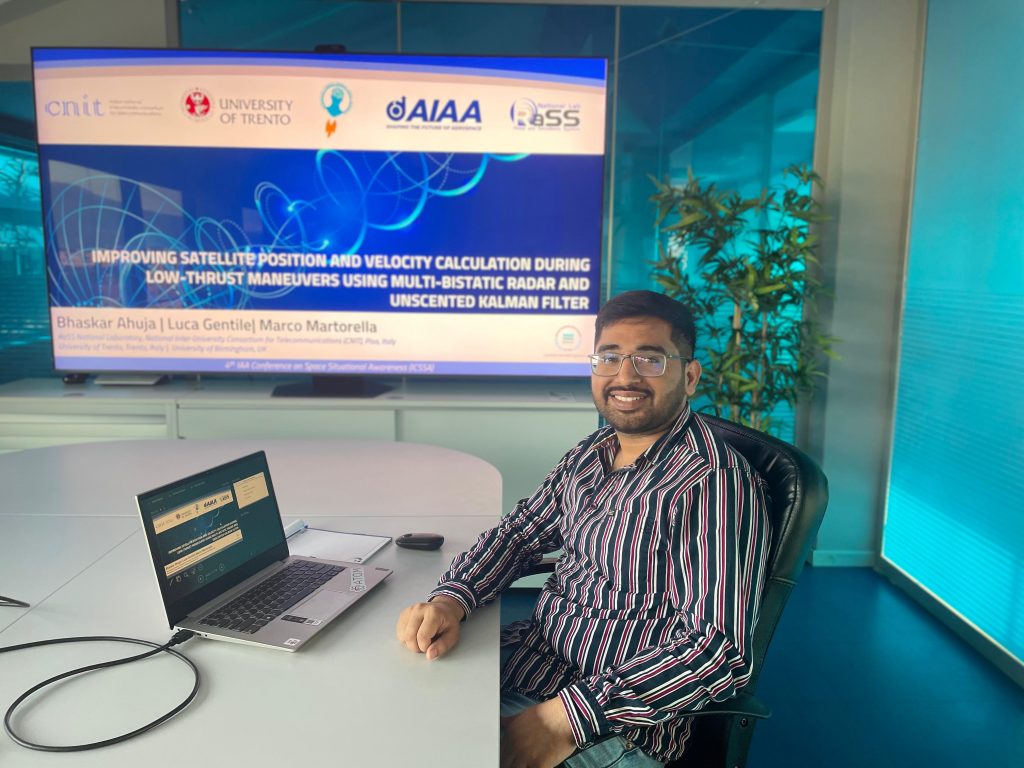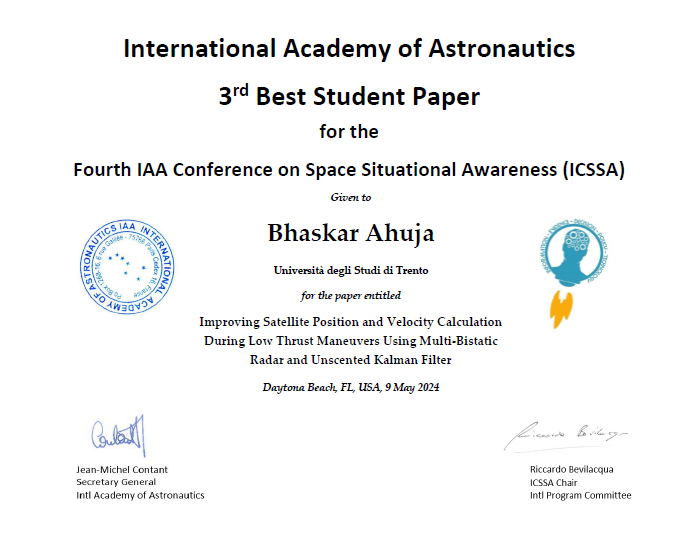We are pleased to announce that our researcher Bhaskar Ahuja (PhD CNIT – Consorzio Nazionale Interuniversitario per le Telecomunicazioni and Università di Trento) presented transformative research at the 4th IAA Space Situational Awareness Conference and received the 3rd Best Paper Award for his outstanding work.
This study introduces a novel approach to space surveillance by utilizing remote radio telescopes as bistatic receivers. This significant shift from traditional monostatic radar systems not only leverages existing infrastructure but also considerably enhances the tracking accuracy of Resident Space Objects, particularly when they maneuver.
Abstract:
Nowadays, tracking space objects presents a significant challenge due to the substantial increase in Resident Space Objects (RSOs), especially in the Lower Earth Orbit (LEO) region. The anonymity of spacecraft maneuvers further complicates tracking and leads to inaccurate positioning of the spacecraft. This issue is mainly attributed to imperfections in the implemented data system and the dynamical model. As the number of RSOs in the orbital debris environment continues to grow, an accurate estimation of thrust becomes increasingly important for satellites during maneuvers and low-thrust transfer missions. Conventional methods of thrust estimation rely on post-thrust changes in the orbit’s semi-major axis, which is not real-time. Ground-based sensors, such as radar, provide valuable real-time tracking information, but the costs associated with their implementation and use can be high. This study proposes a cost-effective solution to enhance the real-time accuracy of satellite tracking by using combinations of existing assets. Here, specifically, combination of radar and existing radio telescopes is considered. The proposed solution utilizes an Unscented Kalman Filter (UKF) to estimate state vectors, demonstrating that combining multistatic radar and UKF can significantly improve spacecraft positioning and trajectory prediction. By incorporating tangential thrust into the multistatic radar scenario, the dynamic behavior of the satellite is explored, leading to more precise tracking and control of the satellite in its orbital path.
For a measurement noise of 100 m standard deviation, the proposed system results in an error of less than two percent in all Keplerian parameters, except for eccentricity, which has an error of five percent. Root Mean Square Error (RMSE) analysis conducted for performance evaluation demonstrates significant improvement in position and velocity estimation, validating the proposed system’s effectiveness in enhancing space surveillance capabilities and ensuring better management of satellite movements for various purposes.
Authors:
Bhaskar Ahuja1,2, Luca Gentile2, Marco Martorella2,3
- University of Trento (UniTN), Trento (38123) Italy, bhaskar.ahuja@unitn.it
- RaSS National Laboratory, National Inter-University Consortium for Telecommunications (CNIT), Pisa (56124), Italy, luca.gentile@cnit.it
- University of Birmingham, Microwave Integrated Systems Laboratory (MISL), UK marco.martorella@cnit.it
Some details about the conference
4th IAA Conference on Space Situational Awareness (ICSSA)
Date – May 8-10, 2024
Place – Embry Riddle Aeronautical University in Daytona Beach, Florida, USA



